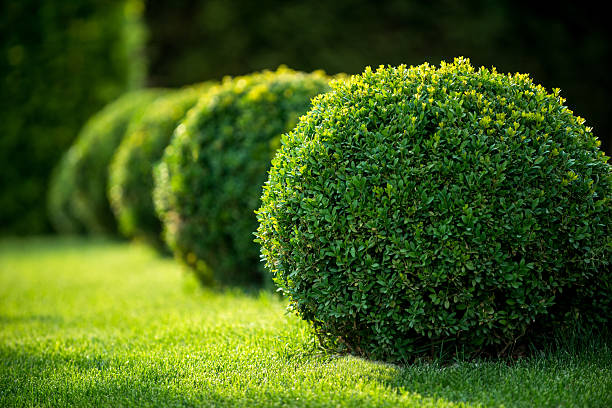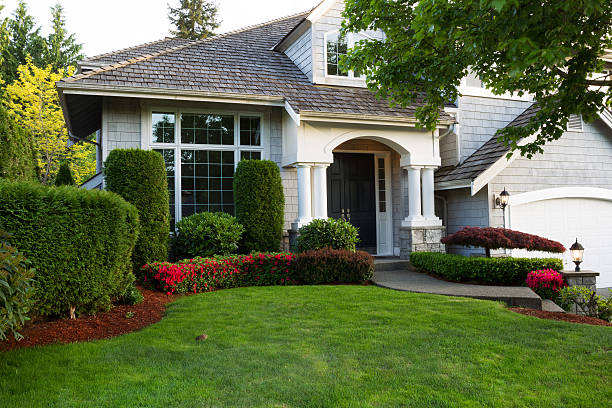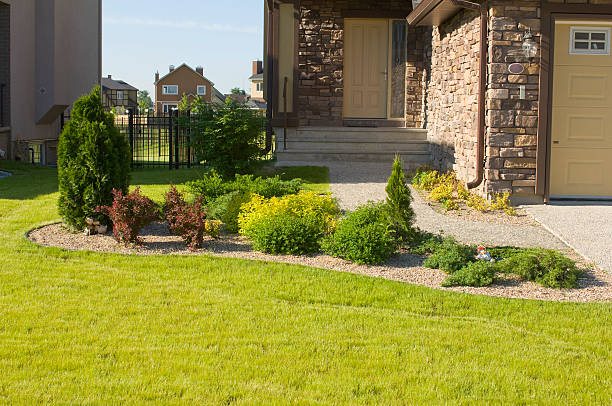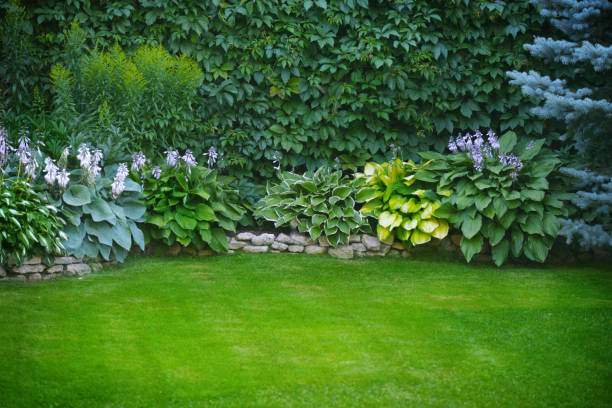5 Reasons Why Fall Is Perfect for Landscaping in Boston, MA
1. Cooler Temperatures Reduce Stress on Plants
- During the fall, cooler air temperatures create less stress on plants compared to the heat of summer. The reduced evaporation rate means plants require less frequent watering.
- Hot days during summer can overwhelm new plantings, while fall’s cooler conditions help plants establish themselves more comfortably.
2. Warm Soil Promotes Root Development
- Soil retains warmth longer than air temperatures as summer transitions into autumn.
- Warm soil encourages active root growth before winter dormancy sets in, enabling plants to establish a strong foundation.
| Soil Condition | Impact on Plants |
| Warm and moist | Encourages root development |
| Dry or overly compacted | Reduces root penetration and water uptake |
3. Fewer Pests and Diseases
- Many pests that thrive during spring and summer become less active as cooler weather sets in.
- The onset of fall lowers the likelihood of plant diseases spreading due to reduced humidity levels.
This creates an optimal environment for planting shrubs, trees, and perennials without the constant threat of pests or fungal issues.
4. Natural Rainfall Aids in Watering
- Autumn typically brings increased rainfall in many regions, reducing the need for supplemental watering.
- Consistent moisture ensures better establishment of new plantings like grass seed or bulbs.
5. Opportunity to Prepare Your Landscape for Spring
Fall is not only about planting; it’s also about preparation: – Apply organic mulch around trees and shrubs to retain soil moisture through winter. – Aerate your lawn to improve root access to oxygen before frost settles in.
Key preparatory steps include: – Clearing debris: Remove fallen leaves or branches that may harbor pests. – Amending soil: Add compost or fertilizers tailored to your plants’ needs during this transitional period.
By addressing these tasks in fall, your landscape will emerge stronger and healthier when spring arrives.
Focusing on landscaping during the autumn months offers numerous advantages that set up your property for long-term success. Whether you’re planting new greenery or simply preparing existing features for colder months ahead, taking advantage of this season ensures vibrant growth come springtime.
How Landscape Design Boston, MA Helps Plants Thrive with Hot Days and Cool Nights During Fall
Fall is a transformative season for landscapes, offering unique advantages for plant growth and establishment. One of the most critical factors contributing to this success is the combination of warm days and cool nights. This temperature balance creates an environment where plants can thrive while minimizing stress, making fall an optimal time for landscaping initiatives.
Benefits of Warm Days for Plant Growth
- Photosynthesis Optimization: Warm days ensure that plants receive ample sunlight necessary to convert energy through photosynthesis. This supports their growth process as they store nutrients for winter dormancy.
- Active Root Development: Soil retains heat from the day, creating a conducive environment for roots to expand and strengthen without being subjected to freezing conditions.
- Prolonged Growing Season: Many plants continue to flourish under warmer fall temperatures before going dormant, allowing gardeners additional time to plant new varieties or improve existing landscapes.
The Role of Cool Nights in Reducing Stress
- Lower Water Loss: Cooler night temperatures reduce evaporation rates, allowing soil moisture levels to remain stable. This ensures that plants have sufficient hydration without requiring frequent watering from irrigation systems.
- Enhanced Sugar Storage: Cool temperatures encourage many plants to store sugars in their roots and stems. These stored reserves help them endure winter conditions and emerge healthier in spring.
- Reduced Pest Pressure: Unlike hot summer months when pests are at their peak activity level, cooler nights discourage many insects from thriving, minimizing damage to your garden.
How These Conditions Work Together
| Factor | Warm Days | Cool Nights |
| Photosynthesis | Accelerated | Minimal |
| Water Retention | Moderate evaporation | Reduced evaporation |
| Pest Activity | Moderate | Low |
| Root Development | Active | Stable |
Tips for Maximizing Fall Growth Conditions
To make the most of these favorable temperature patterns during fall: – Select native or hardy plant species that acclimate well to fluctuating weather. – Provide consistent watering early in the day so soil has adequate time to absorb moisture before cooler overnight temperatures set in. – Mulch around trees or shrubs to retain soil warmth during cooler evenings. – Avoid over-fertilizing; focus on using slow-release fertilizers designed for fall application.
By understanding how daytime warmth complements nighttime cooling patterns, homeowners can strategically plan their landscaping efforts in autumn. This ensures better results not only during the current season but also as plants transition into spring stronger than ever before.
How Soil Temperatures in Boston, MA Landscape Promote Plant Growth Before the Frost
Fall is an ideal time for landscaping and planting due to the unique, moderate soil conditions. As summer transitions into fall, the soil retains warmth while the air begins to cool, creating an environment that encourages robust root development. Here are some reasons why fall soil temperatures are particularly beneficial for plant growth.
Optimal Soil Temperatures for Root Development
- Consistent Warmth: During fall, soil temperatures remain stable and warm enough to stimulate root activity without the stress caused by extreme heat.
- Encourages Root Expansion: Plants focus more energy on establishing strong roots rather than producing foliage during this period.
- Prepares Plants for Dormancy: By promoting healthy root systems now, plants are better prepared to survive winter dormancy and thrive in spring.
| Soil Temperature Range | Ideal Planting Impact |
| 50°F – 65°F | Encourages root growth without overexerting the plant. |
| Below 50°F | Can slow or stop root development entirely. |
Reduced Stress from Hot Weather
- Cooler Air with Warm Soil: The combination of hot days followed by cooler nights allows plants to grow without excessive water loss through transpiration.
- Lower Risk of Pests: Many pests and diseases diminish as temperatures drop, reducing threats to young plants.
Enhanced Nutrient Availability
- Improved Absorption: Warm soil enhances microbial activity, which breaks down organic matter into nutrients that plants can absorb more easily.
- Fertilizer Effectiveness: Fertilizers applied in early fall have more time to integrate into the soil before winter sets in.
Pro Tip: Conduct a soil test in late summer or early fall to determine any nutrient deficiencies before planting.
Easier Maintenance Ahead of Frost
- Gardeners save time during spring as established plants will require less maintenance.
- Plants benefit from natural insulation provided by mulching after planting, protecting roots from frost damage.
Key Takeaways for Fall Planting Success
- Choose hardy perennials, shrubs, or trees that thrive when planted in fall.
- Use mulch generously after planting to retain warmth and moisture in the soil.
- Monitor weather patterns closely; avoid planting if frost is imminent within a week.
Fall’s moderate soil conditions give landscapers and homeowners alike an opportunity to lay a strong foundation for vibrant gardens come spring. By understanding how these temperatures promote plant growth effectively during this period, you can make strategic landscaping decisions with long-term benefits.
How Soil Temperatures Promote Plant Growth: Tips from a Landscaper Boston, MA
Fall is often overlooked as a prime time for planting and landscaping, but one of the key reasons it’s so effective lies in soil temperatures. During this season, the ground remains warm from the heat absorbed during summer, even as air temperatures begin to cool. These stable soil conditions present unique advantages for plants and gardeners alike. Below, we’ll delve into how fall soil temperatures support plant growth and why this period is critical for establishing a vibrant landscape.
The Importance of Warm Soil: Insights from Landscaping Companies in Boston, MA
When the soil maintains consistent warmth, it creates an environment conducive to root development and nutrient absorption. Roots are essential for anchoring plants and ensuring they receive proper hydration and nutrients. Fall’s temperate soil allows roots to continue growing until frost sets in, giving them a head start before winter dormancy.
Benefits of warm soil: – Enhanced Root Establishment: Plants focus on developing robust root systems when they are not stressed by extreme heat or cold. – Improved Water Retention: Cooler air reduces evaporation rates, allowing warm soils to retain moisture necessary for root absorption. – Increased Nutrient Availability: Microbial activity in warm soils remains active longer into fall, breaking down organic matter into nutrients that plants can easily take up.
Understanding Fall Soil Conditions for Lawn Care Boston, MA
| Season | Soil Temperature | Plant Development Focus | Challenges |
| Spring | Cool to warming | Germination and early root growth | Risk of late frosts; unpredictable rain |
| Summer | Hot | Above-ground growth (leaves/flowers) | Heat stress; high evaporation rates |
| Fall | Warm but cooling | Root establishment | Minimal challenges (ideal conditions) |
| Winter | Cold/Frozen | Dormancy | Frozen soils impede water uptake |
As shown above, fall offers the best balance between favorable soil temperatures and minimal external stressors.
Enhancing Your Boston, MA Landscape Design for Optimal Soil Use
- Plant Perennials: Trees, shrubs, and perennials benefit most from fall planting because their roots can establish themselves before winter.
- Amend Your Soil: Adding compost or organic material improves nutrient content while supporting beneficial microbes that thrive in warm soils.
- Mulch Strategically: A layer of mulch helps insulate the soil from sudden temperature drops while retaining moisture.
- Test Your Soil: Conduct a pH test in early autumn to determine if amendments like lime or sulfur are needed to optimize growth conditions.
Landscaping Tips for Plants That Thrive in Boston, MA This Fall
- Bulbs such as tulips and daffodils
- Hardy shrubs like hydrangeas or boxwoods
- Cool-season vegetables including spinach, kale, or garlic
- Ground covers such as creeping thyme or clover
By planting these species during fall’s optimal window, you set them up for long-term success without competing with challenging summer conditions or dormant winter months.
Understanding how warm soil benefits plant development before frost enables landscapers and gardeners to make informed decisions about their planting schedule. With proper preparation and plant selection during this time, your landscape will flourish come springtime.
5 Reasons Why Fall Is Perfect for Landscapers Boston, MA to Plant and Prepare Your Landscape
Fall is a season that provides optimal conditions for planting and preparing your landscape for long-term success. While spring often takes the spotlight as the prime gardening season, autumn offers unique advantages that can benefit both new and existing landscapes. Here are five compelling reasons why fall is the perfect time to focus on your outdoor space.
1. Moderate Temperatures Are Gentler on Plants
The cooler temperatures of fall reduce stress on plants, making it easier for them to establish strong root systems. Unlike summer’s scorching heat, the combination of warm soil and cooler air encourages healthy growth without overwhelming plants.
- Plants experience less water loss due to reduced evaporation.
- Lower temperatures minimize the risk of heat stress or wilting.
- Fewer pests and diseases thrive in cooler weather, protecting your plants.
2. Optimal Soil Conditions Encourage Root Development
During fall, soil retains warmth from summer while gradually cooling down. This creates an ideal environment for roots to grow and anchor themselves before winter sets in.
| Benefit | Explanation |
| Warm soil | Promotes faster root growth compared to spring. |
| Improved moisture levels | Fall rainfall softens the soil for easier planting. |
Planting in fall ensures that roots are well-established by spring, allowing plants to thrive once they begin their active growth phase.
3. Fall Rainfall Creates Natural Irrigation
Autumn often brings consistent rainfall, which reduces the need for supplemental watering during this critical establishment period.
- Ensures even hydration across newly planted areas.
- Helps leach salts or chemicals from the soil that may hinder plant growth.
- Saves time and resources by lowering reliance on irrigation systems.
This natural moisture helps create a low-maintenance environment when preparing your landscape during fall.
4. Reduced Competition from Weeds
Weed growth slows significantly as temperatures drop in the fall. This decline provides an opportunity for new plants to take root without competing with fast-growing invasive weeds.
Key Advantages: – Allows you to focus on nurturing desired plants rather than constant weeding. – Reduces weed seed germination due to shorter daylight hours.
By getting ahead of weed management now, you’ll have fewer issues come springtime.
5. Prepares Your Landscape for a Strong Start Next Year
Fall planting ensures that trees, shrubs, perennials, and even bulbs have ample time to establish themselves before winter dormancy kicks in. This head start leads to healthier growth when spring arrives.
Types of Landscaping Projects Perfect for Fall:
1. Establishing new lawns (especially cool-season grasses).
2. Planting spring-blooming bulbs like tulips and daffodils.
3. Adding native shrubs or trees tailored to your region’s climate conditions.
By dedicating time to landscaping in the fall, you’ll set yourself up for a flourishing outdoor space come springtime while giving plants their best chance at long-term success.
How to Transform Boston, MA Landscapes with Fall Bulb Planting for Spring Blooms
One of the most rewarding aspects of gardening is seeing vibrant blooms emerge after a long winter. Planting bulbs in the fall is a crucial step to achieve this seasonal transformation. Fall planting allows bulbs to establish strong root systems during cooler months, ensuring they are ready to thrive when spring arrives. Here’s why this practice is essential and how it benefits your landscape.
The Science Behind Fall Bulb Planting
- Dormancy and Root Development: Bulbs remain dormant during winter but focus on root growth when planted in fall. This gives them a head start for healthy spring bloom.
- Temperature Regulation: Cool soil temperatures allow proper rooting while preventing premature sprouting.
- Moisture Benefits: Fall rains naturally hydrate the soil, reducing the need for extensive watering.
Ideal Bulbs for Fall Planting
| Bulb Type | Bloom Time | Sun Preferences | Color Range |
| Tulips | Early to mid-spring | Full sun | Red, pink, yellow, white |
| Daffodils | Early to late spring | Full sun/partial shade | Yellow, white |
| Crocuses | Late winter/early spring | Full sun/partial shade | Purple, yellow, white |
| Hyacinths | Early to mid-spring | Full sun | Blue, purple, pink |
| Alliums | Late spring/summer | Full sun | Purple, white |
Plant a combination of these bulbs for staggered blooms throughout the season.
Steps to Successful Fall Bulb Planting
- Choose Quality Bulbs
Inspect bulbs before purchase. Healthy ones should feel firm and free from mold or damage. - Plan Your Layout
Group bulbs together in clusters or patterns for visual impact rather than planting them individually. - Loosen soil about 6–8 inches deep.
- Mix in compost or organic matter for added nutrients.
- Most bulbs should be planted at a depth equal to 2–3 times their height.
- Space bulbs according to their type; larger varieties require more room.
- Water Thoroughly
After planting, water well to settle the soil around the bulb roots. - Add Mulch
A layer of mulch helps regulate temperature and retain moisture during winter months.
Common Mistakes To Avoid
- Planting too early or late: Check local frost dates and aim for mid-fall when soil is cool but not frozen.
- Overwatering: Excessive moisture can cause bulb rot.
- Ignoring pests: Squirrels and rodents may dig up freshly planted bulbs; use wire mesh if needed.
Benefits of Fall-Planted Bulbs
- Early bursts of color brighten your garden before other plants awaken from dormancy.
- Minimal maintenance required once established.
- Increased biodiversity attracts pollinators like bees and butterflies in spring.
Invest time this fall preparing your garden with carefully selected and properly planted bulbs—it will reward you with a breathtaking display come spring.
Creative Ideas for Enhancing Your Property with Seasonal Outdoor Planters
Seasonal outdoor planters are a fantastic way to add charm, color, and personality to your property. These versatile additions can transform any space into an inviting and visually appealing area, no matter the season. Whether you’re a homeowner looking to spruce up your backyard or a business owner aiming to create a welcoming atmosphere, outdoor planters can help achieve your goals effectively. Here are some creative ideas and tips for maximizing their potential.
Benefits of Seasonal Outdoor Planters
- Flexibility: Easily customize planters with seasonal plants and flowers.
- Low Maintenance: Less commitment than in-ground landscaping while still providing beauty.
- Mobility: Move planters around to adapt to different spaces or lighting conditions.
- Cost-Effective: A budget-friendly way to refresh the look of your outdoor area.
Design Ideas for Every Season
Spring
- Combine tulips, daffodils, and hyacinths for vibrant springtime color.
- Include trailing ivy or creeping jenny for added texture.
- Use pastel-colored pots or decorative containers.
Summer
- Opt for sun-loving plants such as petunias, geraniums, and marigolds.
- Incorporate grasses like fountain grass for height and movement.
- Consider adding herbs such as basil or lavender for visual interest and functionality.
Fall
- Choose warm-colored flowers like chrysanthemums, pansies, and ornamental peppers.
- Add natural elements like pumpkins, gourds, or dried corn stalks around the base of your planters.
- Use rustic wooden or terracotta containers that blend with autumn’s earthy tones.
Winter
- Use evergreens such as dwarf spruce or juniper as the focal point of your arrangement.
- Add pops of red with winterberries or holly branches.
- Decorate with pinecones, ribbons, or string lights to create festive displays.
Pro Tips for Creating Eye-Catching Planters
- Thriller: Include one tall plant that serves as the centerpiece (e.g., grasses or small shrubs).
- Filler: Use medium-sized plants with lush foliage or flowers (e.g., begonias).
- Spiller: Add trailing plants that cascade down the sides (e.g., sweet potato vine).
- For small patios or balconies, use vertical planters to save space while maximizing impact.
- For large driveways or entryways, group several coordinated planters together in varying sizes.
- Use Suitable Materials
Select weather-resistant materials such as fiberglass or metal pots if exposed to harsh conditions. - Pay Attention to Drainage
Proper drainage is essential for preventing root rot—ensure each container has adequate drainage holes.
Example Planting Combinations by Season
| Season | Thriller | Filler | Spiller |
| Spring | Daffodils | Pansies | Creeping Jenny |
| Summer | Ornamental Grass | Petunias | Sweet Potato Vine |
| Fall | Ornamental Kale | Chrysanthemums | Ivy |
| Winter | Dwarf Spruce | Holly | Wintergreen Trailing Vines |
Seasonal outdoor planters not only enhance curb appeal but also allow you to express creativity through design updates throughout the year. With thoughtful planning and plant selection tailored to each season’s characteristics, you can create stunning arrangements that elevate any property’s aesthetic value year-round.
- Best Time to Start Your Boston, MA Landscapes Project for Stunning Results
- 5 Reasons Why Fall Is Perfect for Landscaping in Boston, MA
- Essential Guide to Landscaping Boston, MA: Tips for a Thriving Outdoor Space
- Step by Step Guide to Boston, MA Landscape Care for Beginners and Professionals
- How Landscaping Boston, MA Homes Benefits Plant Growth During Cooler Fall Temperatures
- Discover Why September is Ideal for Transforming Boston, MA Landscapes
- The Best Time of the Year for Landscaping Boston, MA and Transforming Your Outdoor Spaces








